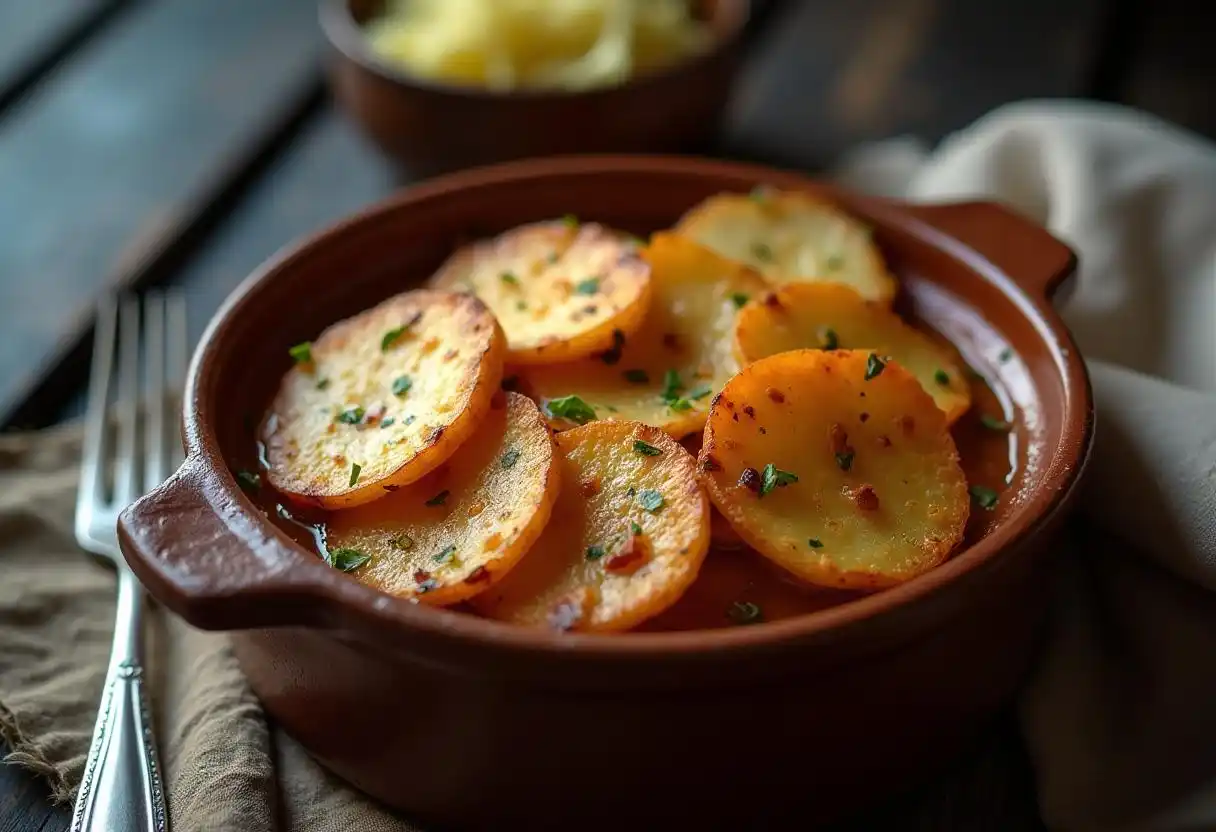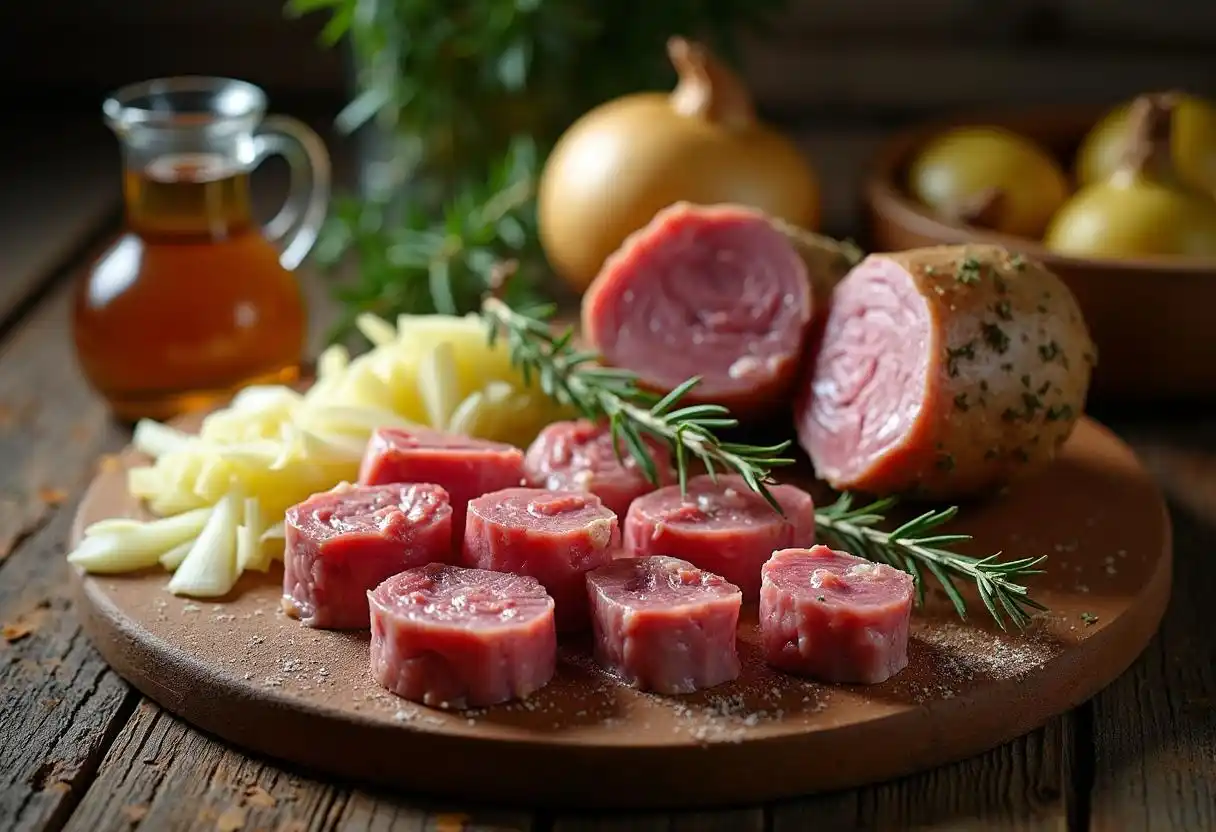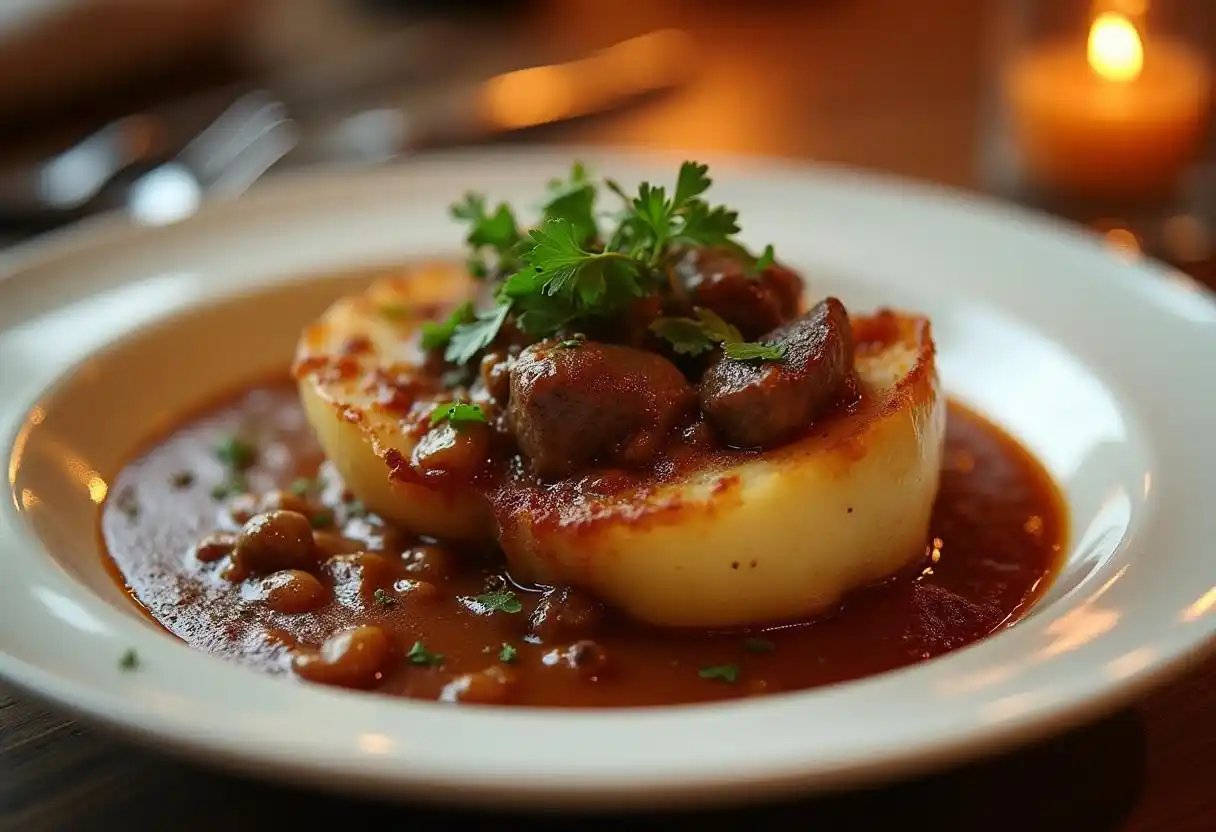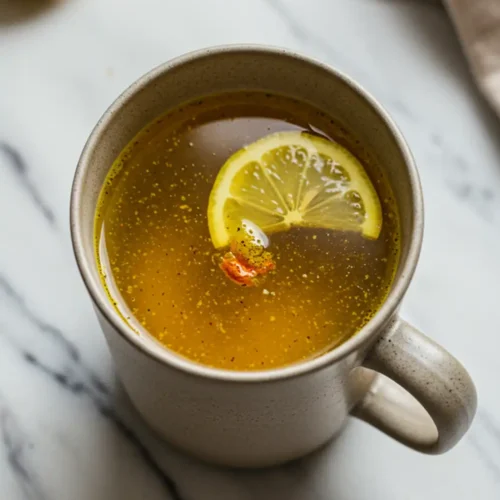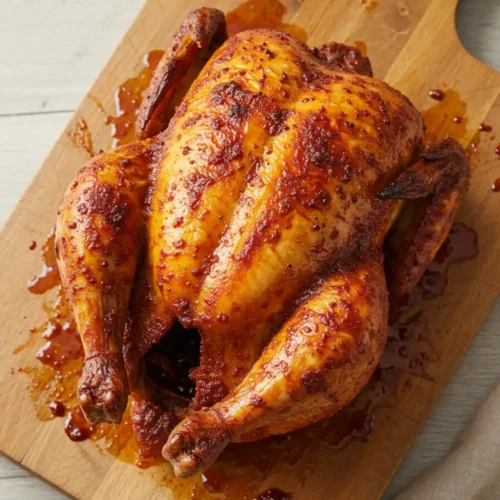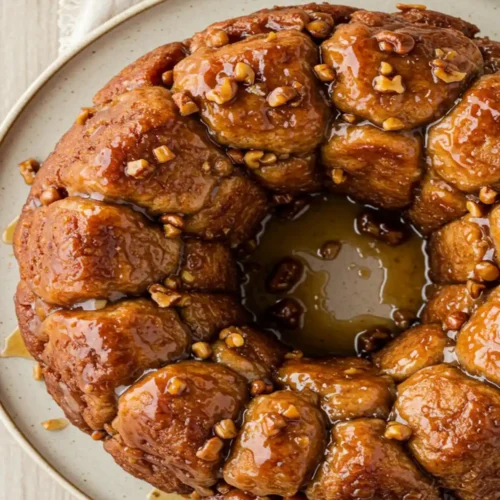Okay, y’all, let’s chat about food names for a sec. Some just make you scratch your head, right? Like, who decides these things? Take Lancashire hotpot – sounds so proper and British, doesn’t it? My husband, the history teacher, probably knows the backstory off the top of his head (and would likely make a terrible pun about it), but for the rest of us, it’s kinda intriguing! This cozy, hearty dish is pure comfort food, and its name actually tells a story. So, grab a cuppa (or a glass of vino!), and let’s figure out why is it called Lancashire hotpot together.
What is Lancashire Hotpot?
A Hug in a Bowl
First off, what is this magical dish? Imagine tender, melt-in-your-mouth lamb mingling with soft, sweet onions, all tucked under a cozy blanket of thinly sliced potatoes that get gloriously crispy on top. Mamma mia! Traditionally, it’s super simple, relying on just a few star ingredients. But oh, the comfort! It’s seriously like getting a warm hug from the inside out – perfect for a chilly Portland evening (or anywhere, really!).
Why is it Called Lancashire Hotpot?
So, that name? It’s actually pretty straightforward, which I appreciate! No secret codes here:
- Lancashire: This points straight to its hometown – a region up in Northwest England. That’s where this deliciousness was born!
- Hotpot: This bit describes how it’s traditionally cooked – simmered slowly in one pot (a “hot pot,” get it?). Simple, effective, delicious.
See? The name tells you where it’s from and how it’s made. I love that! It feels honest and homey, just like the dish itself.
History of the Lancashire Hotpot
Roots in the Industrial Revolution
Now for a little history lesson (my husband would be so proud!). This dish basically powered the Industrial Revolution in Lancashire. Okay, maybe that’s a slight exaggeration, but seriously! Back then, folks working long, hard hours in the mills and factories needed food that was cheap, filling, and easy. Hotpot was the answer! They could literally leave it simmering away in a low oven or on the hearth all day while they worked, then come home exhausted to a hot, hearty meal waiting for them. Genius, right? Talk about practical comfort food!
Adapting Through the Years
Like any good recipe passed down through generations (kinda like my Nonna’s Sunday gravy!), Lancashire hotpot has seen little tweaks here and there. While the heart of it – lamb, potatoes, onions – stays the same, people have added their own touches over time. Maybe a different herb, a splash of something extra… but that cozy, simple essence? That never changes.
Want a deeper dive into its story? Check out this historical overview from Kitchen Sanctuary.
Ingredients That Define a Lancashire Hotpot
The Key Components
At its core, a true Lancashire hotpot keeps things beautifully simple. You absolutely need these three amigos:
- Lamb: Usually shoulder or neck – cuts that get incredibly tender with slow cooking. We talked all about the best cut of lamb for hotpot recently!
- Potatoes: Sliced thinly and layered on top to create that signature golden crust. Heaven!
- Onions: Lots of ’em! They cook down and add a wonderful sweetness that balances the rich lamb.
Seasonal Adaptations
While the classic trio is fantastic, sometimes people jazz it up with seasonal veggies, especially in the fall. A layer of sliced carrots or parsnips tucked under the potatoes? Delicious! It adds extra flavor, texture, and vitamins. Nonna always said to cook with the seasons!
Cooking Techniques: Traditional vs. Modern
Old-Fashioned Preparation
The OG way? Layering everything up in a sturdy pot (the “hotpot”!), pouring over some stock, covering it tightly, and letting it simmer gently for hours and hours on a low heat source, maybe even in the embers of a fire back in the day! This slow, patient cooking is what makes everything meld together into pure comfort.
Modern Approaches
Let’s be real, most of us aren’t cooking over embers anymore! Nowadays, we adapt. Slow cookers are PERFECT for hotpot – set it and forget it! Ovens work beautifully too, giving you that lovely browned potato topping. These modern methods make this historic dish totally doable for our busy lives. I love using my slow cooker for recipes like this or even my Crock Pot Japanese Curry.
What Makes Lancashire Hotpot Unique?
Comparison to Scouse
Okay, so how is it different from other British stews? Let’s take Scouse, another Northern classic (from Liverpool). While both are cozy meat-and-potato dishes, they’re definitely distinct:
- Lancashire Hotpot: Stars lamb, layered construction, rich gravy, distinct potato topping.
- Scouse: Usually uses beef (or lamb), more of a chunky stew where everything’s mixed, often brothier.
Comparison to Irish Stew
And what about Irish Stew? Another lamb and potato favorite, but again, different vibes:
- Irish Stew: Often simpler, maybe lighter broth, sometimes includes herbs like thyme or parsley mixed in. The potatoes are usually chunks within the stew.
- Lancashire Hotpot: Generally has a richer, thicker gravy (thanks to slow cooking and maybe a little flour) and that signature crispy potato lid. You can explore the differences between stew and hotpot in more detail if you’re curious!
Lancashire Hotpot in Modern British Cuisine
You might think a dish this old-school would fade away, but nope! Lancashire hotpot is still going strong. You see it on cozy pub menus all over the UK, and even fancy restaurants do their own gourmet takes on it sometimes. It proves that true comfort food never goes out of style. It just adapts a little, keeping its soul while fitting into our modern world.
Cultural Symbolism of the Lancashire Hotpot
Beyond just being yummy, this hotpot is like a taste of Northern England’s history. It represents that hardworking, make-do, no-nonsense spirit from the Industrial Revolution days. It’s practical, warming, and brings people together – born from tough times but embodying resilience and community. Kinda cool how food can do that, huh?
Lancashire Hotpot vs. Other Regional Dishes
Comparing to Scouse
- Main Star: Hotpot = Lamb. Scouse = Usually Beef.
- Texture: Hotpot = Layered with crispy top, thicker gravy. Scouse = Mixed stew, often thinner broth.
Contrasting with Irish Stew
- Roots: Hotpot = English industrial workers. Irish Stew = Irish countryside traditions.
- Style: Hotpot = Defined by that neat potato topping. Irish Stew = More about the mix of lamb, potatoes, and maybe other roots/herbs in the broth.
Is Lancashire Hotpot Still Relevant Today?
Oh, absolutely! In a world obsessed with food trends, there’s something incredibly grounding about a classic like this. People still crave that comforting, home-cooked flavor. Plus, it’s adaptable! You see vegetarian versions now, lighter takes… it keeps evolving while holding onto its cozy roots. It’s definitely still relevant and loved.
Health and Nutritional Aspects
Okay, let’s be real, it’s not exactly salad! But it’s not terrible either. It’s a pretty balanced meal in one pot:
- Protein? Check! (Thanks, lamb!)
- Carbs? Check! (Hello, potatoes!)
- Vitamins? Check! (From the onions and any extra veggies you sneak in!)
You can always make it a bit healthier by trimming the lamb well, using leaner cuts (though see our warning above!), maybe adding more veggies, or using less butter on top. It can definitely be part of a wholesome family dinner.
How to Make an Authentic Lancashire Hotpot
Components You’ll Need
(This is a basic guide, amounts can vary!)
- Around 1 lb (500g) lamb shoulder or neck, cut into chunks
- About 2 lbs (1kg) potatoes (like Maris Piper or King Edward if you can find them, otherwise Russets work), peeled and sliced thinly
- 2 large onions, sliced
- About 2 cups (500ml) beef or lamb stock (or veggie stock)
- A little butter (or oil) for greasing the dish and brushing the top
- Salt and freshly cracked black pepper
Step-by-Step Instructions
- Oven On!: Get your oven preheating to around 340°F (170°C).
- Layer Up: Grease a casserole dish or Dutch oven. Start layering: some onions, then lamb chunks, then some potatoes. Season each layer with salt and pepper! Repeat until everything’s in, ending with a layer of potatoes.
- Add Stock: Carefully pour the stock over everything. It should come up most of the way but not completely cover the top potato layer.
- Neaten the Top: Arrange the final layer of potato slices nicely, overlapping them like shingles on a roof.
- Butter ‘Em Up: Brush the top potato layer with a little melted butter (or oil). This helps them get golden and crispy.
- Slow Cook: Cover the dish tightly with a lid or foil. Bake for about 2 hours. Then, take the cover off for the last 30 minutes to let those potatoes get beautifully browned and crisp. The lamb should be super tender!
Need more guidance? Here’s a step-by-step guide to making a traditional Lancashire hotpot, with tips for perfect potatoes.
Common Variations of Lancashire Hotpot
Vegetarian Versions
Like I mentioned, veggie hotpots are totally a thing! Instead of lamb, folks use hearty lentils, chunks of mushrooms (portobello!), or a mix of root veggies like parsnips, sweet potatoes, and carrots. With good veggie broth and herbs, you still get that comforting, delicious vibe.
Contemporary Twists
Modern cooks love to play! Some add herbs like rosemary or thyme along with the lamb. Maybe a splash of Worcestershire sauce or even a dark ale in the broth for extra depth. Sometimes you see cheese or breadcrumbs sprinkled over the potatoes before the final browning for extra crunch. It’s all good!
The Legacy of the Lancashire Hotpot
Lancashire hotpot is way more than just dinner; it’s a delicious piece of history you can eat! It tells a story about hardworking people, making do, and finding comfort in simple, nourishing food. Every time we make it, we’re kinda connecting with that past, keeping a tasty tradition alive. That’s pretty special, I think.
Ready to make your own comforting pot? Here’s my favorite detailed recipe for a Lamb Hotpot, packed with tips to make it absolutely perfect!
FAQs About Lancashire Hotpot
Q: What is the difference between Scouse and Lancashire hotpot?
Q: What is the history of the Lancashire hotpot?
Q: Why is it called Lancashire?
Q: What is the difference between Lancashire hotpot and Irish stew?
Conclusion
So, now you know why it’s called Lancashire hotpot ! It’s a name rooted in place and practicality, born from the hardworking history of Northwest England. From its simple beginnings fueling factory workers to its cozy spot on modern menus, this dish is way more than just lamb and potatoes – it’s a delicious symbol of tradition, resilience, and the enduring power of comfort food.
It’s the kind of food that warms you from the inside out, perfect for sharing with family – maybe even gets a thumbs-up from my picky son AND my chatty little kitchen helper (who loves arranging the potatoes!). Its history is just as rich as its gravy!
Next time you tuck into a steaming bowl, maybe you’ll appreciate its story just a little bit more. It’s a reminder that good, honest food, made with simple ingredients and a bit of patience, is always something special. Buon appetito, amici!

